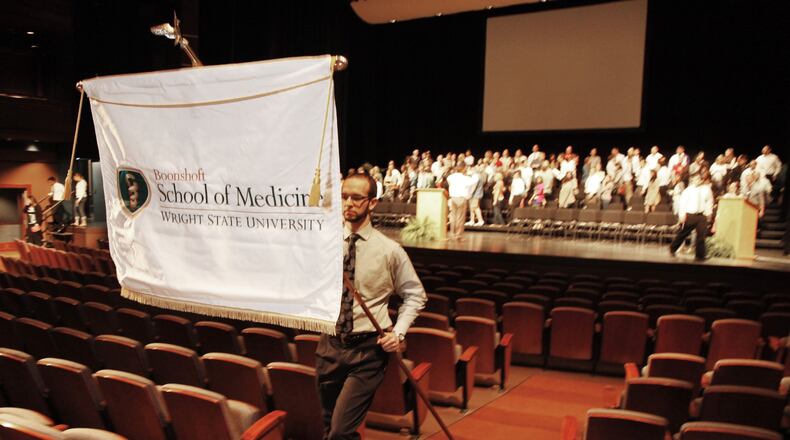Margarette Shegog knows she won't be "making the big bucks" as a primary care doctor working in an under-served minority community, but that's exactly what she plans to do after graduating from Wright State University's Boonshoft School of Medicine on Friday.
"I know I would get paid a higher salary as a specialist, and I have a ridiculous amount of debt" from medical school, said Shegog, a 32-year-old Cincinnati resident. "But I see how much need there is in under-served communities, and I want to do family medicine in those communities so I can service the most people."
Shegog, who hopes to get help repaying her student loans through a government program that pays doctors a stipend for working in needy communities, said she was inspired by her two-year stint as a Peace Corps volunteer in Namibia helping impoverished HIV/AIDS patients seek medical care.
"It was extremely frustrating to have my students say, hey, I'm HIV positive, and all I could say was you need to go see a doctor," Shegog lamented. "That's when I said to myself I need to prescribe medication."
But Shegog's career medical path is unusual in Ohio and nationwide. Only about 16 percent of the 106 Boonshoft graduates who participated in commencement ceremonies at the Schuster Performing Arts Center in downtown Dayton are expected to join Shegog in family practice, according to school officials. And the numbers are not much better at even the best schools for producing family doctors.
About 21 percent of this year's graduates at The Brody School of Medicine at East Carolina University have chosen to pursue family medicine — the highest percentage in the country, according to the American Academy of Family Physicians.
"There's still a stigma within the medical community about family medicine," Shegog said, referring the perception among many of her peers that primary care is less prestigious than specialties and sub-specialties, such as cardiology. "I've had other students and other physicians tell me, ‘Don't sell yourself short. You know you can do things other than family medicine."'
Medical students discouraged from joining family practices are part of the reason the need for primary care physicians has never been greater.
In addition, increased demand from the more than 15 million people expected to gain health insurance next year through health care reform and an aging Baby Boom generation with greater health care needs are also expected to drive a nationwide shortage of 62,100 physicians, including 33,100 primary care practitioners by 2015, the Association of American Medical Colleges estimates.
"This is a trend that has been going on since the mid-90s," said Dr. Gary LeRoy, past president of the Ohio Academy of Family Physicians who has a practice in Dayton. "It's the 800-pound gorilla in the room that we continue to ignore."
Filling the need remains a daunting challenge, which is unlikely to change until health care payers — including Medicare, Medicaid and private insurers — reimburse primary care physicians at the same rate they pay specialists for services, LeRoy said.
"We, as a society, have elected to pay the sub-specialist the most to do various procedures," he said. "I don't begrudge that because, Lord knows, we need them, but we also need to put a primary focus on primary care and realize that is where the focus needs to be to treat all the masses of people who need health care in this country."
President Barrack Obama's signature health care law, commonly referred to as Obamacare, would raise Medicaid reimbursements for some primary care doctors to the same level as Medicare, resulting in an average 73 percent raise from Medicaid, according to government figures. And the law also included a 10 percent bonus for primary care providers under the Medicare fee schedule starting in 2011.
That is still woefully short of what would be needed to bridge the pay gap in which the starting salary for a primary care physician can range anywhere from $150,000 to $170,000 a year, while a radiologist or gastroenterologist could start as high as $400,000 a year, according to salary figures from the U.S. Bureau of Labor Statistics.
According to LeRoy, such wage disparities reflect misplaced priorities.
"About 50 percent of diseases can be prevented just by lifestyle modifications; eating correctly, not smoking, exercising," he said. "But that requires intervention with your primary care doctor, and so much of what is not valued or not being paid for on the part of primary care physicians is interventions of that sort."
Another reason for the projected shortage of primary care physicians is the age of the current workforce.
Almost half of all family doctors in the country are 50 or older and approaching retirement age, according to a survey last year from the Physicians Foundation.
Kathleen "Kit" Oxner, another Boonshoft graduate who hopes to work in a family practice, sees the demographic changes as an opportunity.
"I'm hoping to go into practice in Springfield," Oxner, 41, said. "There are a lot of doctors there that are reaching retirement age or the age where maybe they want to cut back a little bit. I'm hoping that will help me find something."
Oxner described primary care doctors as physicians skilled in all aspects of medicine without specializing in one area, but she views the role of a primary care doctor as sometimes even more important than that of a specialist.
"Sometimes primary care doctors can server as the team captain for all the specialists," she said. "When you're the patient, medicine is a completely different language. It's a lot to take in, and you need a good primary care doctor that can oversee your care and interpret what your specialists are telling you."
About the Author
